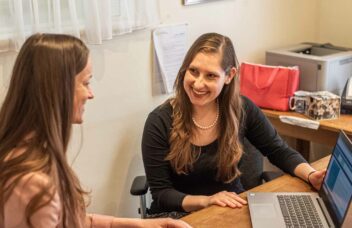


Experience a two-day science event with Rowena Fletcher-Wood, Academic Manager (Science) at Greene’s College Oxford.
After an “interesting” adventure across the country during the train strikes, I had made it to Glasgow for #EnvChem, a two-day scientific meeting where environmental chemists come together to share developments across the field.
The event, for which I was on the organising panel, was jointly produced by three groups of volunteers:
It included four keynote speakers, 25 oral and 22 poster presentations – a veritable marathon of scientific discovery. Topics covered included Scientific Analysis, Citizen Science, Crime, Medicine, and Politics.
Many of the talks focussed on analytical techniques. As a student or parent interested in GCSE and/or A level Science, you may be familiar with chromatography and mass spectrometry, but what about LC-QTOF-MS? This ambiguous and super-long acronym actually describes coupling these analytical techniques, a magic mixture employed by one researcher to detect pharmaceuticals and vaccine transformation products that enter waterways through the sewage (after our bodies expel them). Scientists are interested in how long these contaminants hang around, and how they contribute to antimicrobial resistance. Shockingly, one reported that some of the absorbents we use to get rid of them – activated carbon – can increase horizontal gene transfer – so, solving one problem is causing another!

You will have heard of infra-red, but here Raman and x-ray fluorescent spectroscopies were discussed, approaching challenges like detecting heavy metal contaminants in brownfield sites (primarily post-industrial revolution) that are often rich in “legacy” contaminants, such as Europe’s former largest blast furnace (British Steel’s Teeside Redcar site).

There were also talks about citizen science – science research done by everyday people. Passive sampler devices, for example, a small plastic thing with notches on it that you can hang round your neck or put up outside your home, were handed out to community groups to test water or indoor or outdoor air. Some cool sensors even mimic biological “tasting”.
These studies found that the biggest contaminants were personal care products, and a that one of the top sources of volatile organic compounds, which affect breathing, is cooking!
If you haven’t heard of the Tea Bag Index, you should also check out this innovative studying for checking soil health that any of us can do at home.
Crime prevention themes also emerged. One researcher was using wastewater samples across nine U.K. sites to map out heroin use. Another detected and quantified 29 explosives from environmental samples, providing early warnings for potential bombings. Gold nanoparticles, converted into optical sensors, showed promise for detecting chemical congener trends in whisky samples. This might be used for fraud detection, identifying “fake” whiskies! Nanoparticles could also form part of a circular economy, since other researchers demonstrated they could be easily used for remediation (clean up) and then recovered and recycled.

One team from the NHS reported collecting environmental toxicology data for prescribed drugs that end up in waterways – why? Because we just don’t have this data. It could be used for improving environmental risk assessment and, paired with clinical and cost-effective information, it could revolutionise prescribing practices, giving GPs information about how which drugs they choose for a patient could damage the planet.
In the political sphere, we heard about how loose environmental laws in Africa were leading to high pollution levels, how illegal crop burning (because of how it affects air quality) was being masked by Diwali, and how the Women’s Institute’s Campaign “End plastic soup”, first raised in 2016, brough microplastics – never mentioned before in parliament – to discussion point on 50 occasions since. A single clothes wash releases up to 13,700 microfibres and other key sources can include tyre rub on the road.
We also heard about the challenges of working in different geographies and with different cultures. However, none were as impactful as the Delhi study that required setting up huge cages around their air monitoring equipment – why? To prevent local monkeys from eating their inlet lines, of course.

About Dr. Rowena Fletcher-Wood
Dr. Rowena Fletcher-Wood read her Master’s degree in Chemistry at Somerville College, University of Oxford, specialising in air-sensitive superconducting materials. She obtained a first class honours degree, and a distinction in History and Philosophy of Science. She undertook her doctoral studies at the University of Birmingham, and was awarded her Ph.D. for research into environmental materials (thesis: Zeolites and Other Molecular Sieves for Chromate Remediation). An analytical chemist, she is one of a small number of specialists in Mössbauer spectroscopy. Rowena is the Chair of the Environmental Chemistry Group at the Royal Society of Chemistry and Executive Editor of their biannual Bulletin. She has been teaching Mathematics and the Sciences since 2007, and has worked at Greene’s since 2015, where she is the Academic Manager for Science.
Create your personal prospectus by selecting your interests.
This link will take you to Greene’s International
Proceed